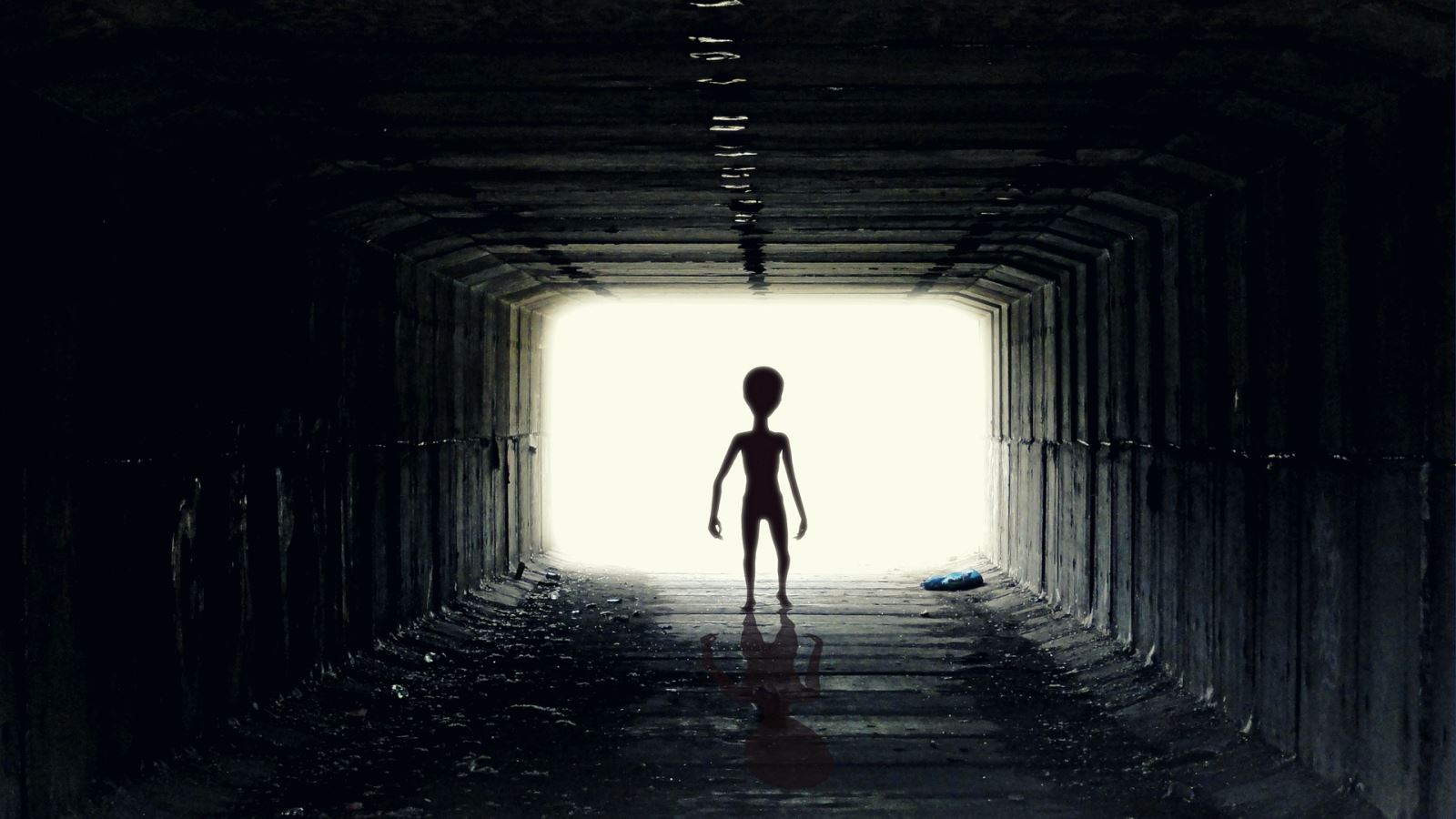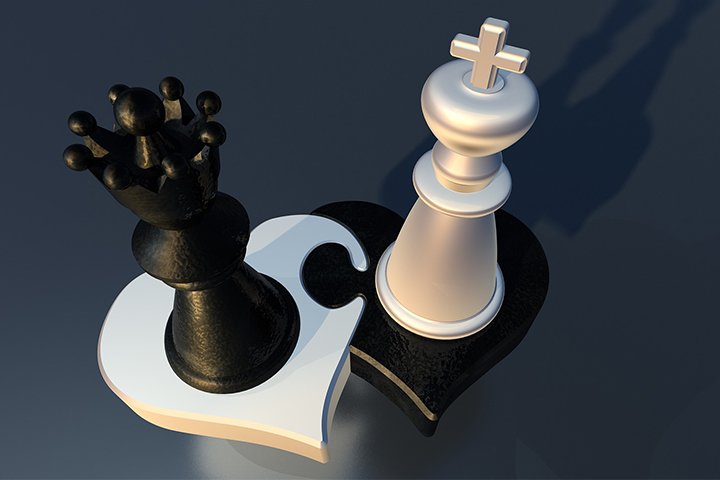Gens una sumus: Friendship tourneys
by Siegfried Hornecker
The Canadian/American TV show "The Outer Limits" showed us wonderful, mysterious, and outright thought-provoking stories. The 1995 reboot ended one episode with the following words that fit into the current day: "Sleep soundly in the knowledge that the dawn will come. Rest assured that our leaders are watching over us. But beware. For it is only their vigilance that stands between our restful slumber... and the end of the world."

While the episode dealt with the possibility of an invasion, in secret, by extraterrestrial forces, it is not far-fetched to apply it to the never-ending possibility of global war. In the new issue of "EG", the specialized endgame studies magazine, I write about a checkmate picture from a tourney in 1962. And I would like to speak about the spirit of said tourney today.
"I am become Death, Destroyer of Worlds!" J. Robert Oppenheimer was astonished and in fear of the monster he had created. The era of conventional warfare had come to an end with the defeat of Adolf Hitler, and the final blow of the war saw the use of two never-seen-before weapons that in the blink of an eye could eradicate entire cities and kill hundreds of thousands of people. The simple message that was sent to Hirohito equaled to "Get out of the war or be destroyed", as the band "Wishful Thinking" would describe it in their song "Hiroshima", named after one of the two cities that were hit by this newly created horror.

Hiroshima Peace Memorial
Seventeen years passed. The United States and the Soviet Union, or rather the NATO and the Warsaw Pact, opposed each other in a Cold War. Both sides had upgraded the monstrous horror, made it fit into intercontinental ballistic missiles. Franz Alt later would write: "Bisher kannten die Menschen nur den individuellen Tod. Der atomare Holocaust wäre aber auch der Tod jeder Geburt und der Tod jedes Todes. Es gäbe erstmals in der Geschichte keine Erinnerung an frühere Generationen und keine Hoffnung auf zukünftige mehr. Wir würden die Toten nochmals töten und unseren eigenen Kindern die Waffe an den Kopf halten."
Roughly this translates to: "Until now, humans only knew individual death. Atomic Holocaust however would also be the death of all birth and the death of all death. For the first time in history there would be no memories of past generations and no hope for future ones. We would kill the deceased again and hold the gun to the head of our own children."
The word "holocaust", from Greek for "burning sacrifice" or "completely burnt", here refers to the Earth being completely inhabitable, "burnt", after such a war.
Both sides were ready to use their weapons, but none was ready to use it first. One mistake, one computer chip burning through, could have meant the end of the world. In 1962 the tensions escalated in the Cuban Missile Crisis. Humanity was as close to its own destruction as it got.
A few months prior, the first "Friendship Team Tourney" was held by chess composers. In endgame studies, the first section was won by Genrikh Kasparyan. The second section was won by the duo Alexey Kopnin and Vladimir Korolkov, the latter whom also won the third section as a duo with Vitaly Chekhover. The first issue of a newly founded quarterly named "EG" printed the studies, and the second issue explained:
International Friendship Match. This is a team composing event to be organised every 3 years. A team represents a country. A FIDE composers' congress in Moscow in 1961 determined the basic details, such as classes of composition - [Mate in 2, Mate in 3, Mate in 4 or more], studies, self- and help-mates. Three themes would be set in each class. The study themes and judges were, for the 1962 results announced this year:
- Mate, with at least two black self-blocks. H.M. Lommer (England).
- Twin positions (or more than two). Only a single discriminant allowed, though the stipulation may vary. R. Voia (Rumania).
- A white ambush (battery) created by a quiet move of the masked piece (R or B). Win or draw.
The late A. Gurvitch (USSR).
(Information obtained from Shakhmaty v SSSR (9/62 and 11/62).
The winners will be replayable below. Don't get fooled by the relatively high number, as the twin study has multiple entries.
The other ranks also had interesting entries. Pierre Drumare (who worked on the Babson task for many years, for which we refer readers to Tim Krabbé's writings) teamed up with Leon Loewenthon to show an interesting smothered mate. All following studies are from the 1st International Friendship Team Tourney 1962.
Pierre Drumare & Leon Loewenthon, section 1, 5th place
White to move and win
1.d8Q+ N:d8 2.Qa3+ Ke8 3.B:f8 R:f8 4.Bd7+ B:d7 5.Nd5 Q:e5 6.Qe7+! Q:e7 7.N:c7 mate
I also like the following study that rather looks like a helpmate. It won also the 2nd prize in the Polish Championship 1963-1964.
Andrzej Trzesowski, section 3, 8th place
White to move and win
1.h6! K:h6 2.Rf4 Bg7 3.Bc1! Bg6 4.Rh4 mate
The ending of the section 2 twin on the second place is interesting.
Frantisek Richter, section 2, 2nd place.
White to move and win (b: bBg1->e3)
After in a) 1.Rb7+ Kc8 2.e3 B:e3 3.Rb8+ K:b8 4.Nd7+ Ka8 5.N:c5 Kb8! and in b) 1.Rb7+ Ka8 2.Rb8+ K:b8 3.Nd7+ Ka8 4.N:c5 Kb8! we reach the critical position.
In the first diagram, White draws only with 6.a4 Ka8 7.Ka5! B:c5 stalemate and in the second diagram White draws only with 5.a4 Ka8 6.a5 Kb8 stalemate. The existence of Pe2 differentiates the two stalemate ideas. The refutation of the wrong line doesn't work in the other diagram, for example with Pe2 in the second diagram the line 6.-Bg1 7.e4! draws, whereas in the first diagram 7.a5? Bg1! would put White in zugzwang, leading to 8.Kc7 B:c5.
The three themes indeed were quite difficult to compose, but some interesting ideas came from them. Knight promotions were used in multiple sections, and while the one for the checkmate with selfblocks had often forced play, the ending position of the following study is fun.
Ernest Pogosyants, section 1, 8th place.
White to move and win.
1.c7 B:f5+ 2.Kg7! Qa8! 3.c8N+ K:e6 4.d5+! Q:d5 5.f8N mate
Such checkmates are known from the border of the board, but are rare with three selfblocks, two of them active, in the middle.
Finally, for the third section it should be noted that domination was a theme that went well with the tourney's theme. One example shall suffice.
Attila Koranyi, section 3, 5th place.
White to move and win.
After the introduction 1.Rg1 Bb6 2.Rh1 c1Q 3.N:d2+ Kc2 4.R:c1+ K:c1 5.Bh6 B:d8 the bishop of Black has far less squares than it looks like, and as such White wins easily, similar to a famous study by Henri Rinck: 6.Ke8 Bc7 7.Kd7 Bb8 8.Kc8 Ba7 9.Kb7 Bf2 10.Ne4+ wins
In 1965, the second International Friendship Team Tourney was held. In EG 9, p. 239-240, an extensive list of rules was given. Nine sections were apparently held, one of them for endgame studies.
Themes: the 8 problem themes a-h are not given here. Section i theme:
"Retroanalysis in an endgame study" (castling, en passant, etc.). Judge: Z. Hernitz (Yugoslavia).
Hernitz had gained the title of International Judge in 1958. A photo of him can be seen on the Chess Composers blog. However, apparently he was replaced as a judge by Savo Vjerko Zlatić, who was famous for his pharmacological work also. In 1999 Zlatić received the title of Honorary Master for Chess Composition, and the information on his Wikipedia page is also interesting to read regarding his political affairs.
A total of 30 places were given in this tourney, the studies however sometimes require difficult retroanalysis, and then sometimes the forward play was cooked. I personally tried correcting the second place by Nenad Petrović multiple times but failed. The original first place by Nikita Plaksin, "a masterpiece" according to John Roycroft in EG 26, was removed from the final award.
As of the knowledge we have today, the first five places are marked as cooked in one way or another in the database of Harold van der Heijden. The sixth place, replayable also below, is a pawn endgame. The tourney certainly has one of the highest percentages of cooks I ever saw in a tourney. If we allow corrections, there are still only 12 of the 30 studies that aren't cooked (without them 10). But not all is hopeless: The fourth place, for example, is a draw study, but White has a winning way. The solution however could be shortened to maintain a correct study. The fifth place has in my opinion rather a minor dual than a completely destructive one. I add also both of those studies to the replayable ones, so readers can decide which study for them should be really the winner. Simple retroanalysis didn't have to be a disadvantage, as also the following study shows.
B. Schlotterbeck, 12th place.
White to move and win
Black has moved last, but there is no possible last move with the queen or any pawn, so he must have moved with his king or rook. As such, castling is impossible, and White wins with 1.Rd3 h5 2.Re3+ Kf8 (the defense after 2.-Qe4 is hopeless, even if immediate checkmate is stopped) 3.Bd6+ Kg8 4.Rg3+ Kh7 5.Rg7+ Kh6 6.Bf4 mate
Apart from Schlotterbeck living in West Germany at the time, I have no further information about him.
With that, already the International Friendship Team Tournaments came to an end. There is however a Friendship tournament in a Soviet magazine in the 1980s, which I think also must be mentioned in this article. It is the "Friendship 200 AT" (AT standing for Anniversary Tourney) of the Achalgazdra Kommunisti in 1983. The study gave out awards as usual, i.e. prizes, honorable mentions and commendations. The preliminary award was published in Georgian in the abovementioned newspaper, but it seems that this was done in a way that one study each week was shown. The date of the final award is unknown. The judge was Gia Nadareishvili (EG 80, p.456).
A total of six prizes, three more special prizes, eight honorable mentions, an additional two special honorable mentions, and eleven unranked commendations was given. The both winners are replayable below, the first special prize was later cooked. The both 2nd/3rd special prize studies feature knight promotions and are given here instead.
Velimir Kalandadze, 2nd/3rd special prize (correction)
White to move and win
The original position had an additional move that led to this position, but it turned out this allowed White to also win by promoting to a queen there. Pawns are difficult to tame. The shortened version still contains all important play:
1.g8N+ Kh5 2.e8N! a1Q+ 3.Ng7+ Q:g7+ 4.K:g7
Without the pawns on the b- and e-file, a deadly zugzwang would be reached.
4.-b5 5.e4 b4 6.e5 b3 7.e6 b2 8.e7 b1Q 9.e8N! Qb7+ 10.Kh8 Qf7 11.Ng7+ Q:g7+ 12.K:g7
Without the pawns on the b- and e-file, a deadly zugzwang now is reached. 13.Nf6 mate follows.
Valery Vlasenko, 2nd/3rd special prize
White to move and draw
1.Nd1! b1N 2.b7 Nc5 3.b8N Kb3 4.Ke7 Kc2 5.Nd7 Ne4 6.Nf6! Ng:f6 (as 6.-Ne:f6 7.Ne3+ draws immediately) 7.Ne2 Nd5+ 8.Ke6 Nec3 9.Ne4 Nf4+ 10.Kf5 Nce2 11.Ng3 draws
Here it is important to remember that three knights win against one, but two against zero is a draw. The variation 1.b7? b1Q 2.b8Q Qf5+, that goes on for a few more moves, is based on queen and two knights winning against queen.
There have been no tourneys with "Friendship" in the name since this one. Unfortunately, it seems that also currently the world is as far away from friendship as it gets.
End note
While I write those lines, not only our world of chess composers is divided ideologically. The war in Ukraine that started last month has taken a huge toll on everyone. Many of our friends are in the war zone, in Ukraine, many others live in Russia and Belarussia. These are dark times, the darkest since I started writing this column, and as such this month's article came into existence while the WFCC was deliberating on if and what measures could be taken in regards of this war. As such, only as a private person this month, not as a spokesman of the studies subcommittee of the WFCC like usual, can I write the article above. We all want this war to end, but we feel powerless. We are just pawns in a game of chess played by the politicians of the world, and now some decided to sacrifice the pawns and to viciously attack the opponents.
In the chess game of world politics, ultimately war can never have a winner, but everyone loses. As the move "Wargames" said, war is a strange game, in which the only winning move is not to play it.
I am deeply saddened.
We should talk about chess, not about politics and war! Do humans still have more that divides them than what unites them? Is it still worth killing each other? Why can't we all just be friends, one extended family? Nearly 100 years ago, on 20 July 1924, a small organization was founded in Paris, one that after the horrors of the first world war, chose as its motto the simple phrase "We all are one extended family!" But, of course, choosing any current language already could have been dividing, so they chose to phrase it in Latin: "Gens una sumus!"
All the events mentioned in the introduction to this article happened after this small organization was founded. An entire century of humans failed to grasp just three words. Maybe one day it can happen.
Let us celebrate each other. Not slaughter. Let us finally be one family!
Correction
The 1st prize of Attila Koranyi in the 2nd Friendship Tourney 1965 is
not incorrect. Werner Keym asked Yours Truly to send him the
incorrectness, and upon checking your author found it to be wrongly
marked as such in the database, but correctly solved in EG 26.
Attila Koranyi, 2nd Friendship Tourney 1965, 1st prize. White to move
and win
As we showed many studies already, we will leave it as a small exercise
for readers to solve this study with retroanalytical content. As a hint,
it is based on the question who can castle. Can White castle? Can Black
castle? Can both castle? Can it be proven that one of them can castle,
but not who – in which case the party that actually castles first proves
by castling that it had the right to do so?
The solution will be shown in this column next month.
Links:

























